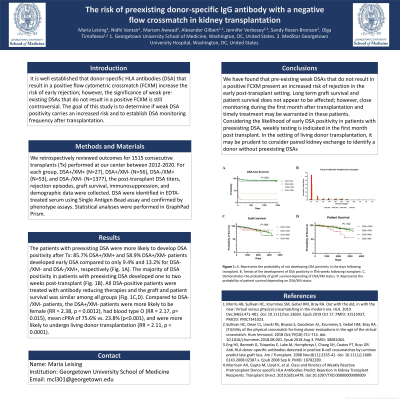Back

(P308) The risk of preexisting donor-specific IgG antibody with a negative flow crossmatch in kidney transplantation
Location: Platinum Ballroom

Poster Presenter(s)
Aim: It is well established that donor-specific HLA antibodies (DSA) that result in a positive flow cytometric crossmatch (FCXM) increase the risk of early rejection; however, the significance of weak pre-existing DSAs that do not result in a positive FCXM is still controversial. The goal of this study is to determine if weak DSA positivity carries an increased risk and to establish DSA monitoring frequency after transplantation.
Method: We retrospectively reviewed outcomes for 1515 consecutive transplants (Tx) performed at our center between 2012-2020. For each group, DSA+/XM+ (N=27), DSA+/XM- (N=56), DSA-/XM+ (N=53), and DSA-/XM- (N=1377), the post-transplant DSA titers, rejection episodes, graft survival, immunosuppression, and demographic data were collected. DSA were identified in EDTA-treated serum using Single Antigen Bead assay and confirmed by phenotype assays. Statistical analyses were performed in GraphPad Prism.
Results: The patients with preexisting DSA were more likely to develop DSA positivity after Tx: 85.7% DSA+/XM+ and 58.9% DSA+/XM- patients developed early DSA compared to only 9.4% and 13.2% for DSA-/XM- and DSA-/XM+, respectively (Fig. 1A). The majority of DSA positivity in patients with preexisting DSA developed one to two weeks post-transplant (Fig. 1B). All DSA-positive patients were treated with antibody reducing therapies and the graft and patient survival was similar among all groups (Fig. 1C,D). Compared to DSA-/XM- patients, the DSA+/XM- patients were more likely to be female (RR = 2.38, p = 0.0012), had blood type O (RR = 2.17, p= 0.015), mean cPRA of 75.6% vs. 23.8% (p < 0.001), and were more likely to undergo living donor transplantation (RR = 2.11, p < 0.0001).
Conclusion: We have found that pre-existing weak DSAs that do not result in a positive FCXM present an increased risk of rejection in the early post-transplant setting. Long term graft survival and patient survival does not appear to be affected; however, close monitoring during the first month after transplantation and timely treatment may be warranted in these patients. Considering the likelihood of early DSA positivity in patients with preexisting DSA, weekly testing is indicated in the first month post transplant. In the setting of living donor transplantation, it may be prudent to consider paired kidney exchange to identify a donor without preexisting DSAs.
Method: We retrospectively reviewed outcomes for 1515 consecutive transplants (Tx) performed at our center between 2012-2020. For each group, DSA+/XM+ (N=27), DSA+/XM- (N=56), DSA-/XM+ (N=53), and DSA-/XM- (N=1377), the post-transplant DSA titers, rejection episodes, graft survival, immunosuppression, and demographic data were collected. DSA were identified in EDTA-treated serum using Single Antigen Bead assay and confirmed by phenotype assays. Statistical analyses were performed in GraphPad Prism.
Results: The patients with preexisting DSA were more likely to develop DSA positivity after Tx: 85.7% DSA+/XM+ and 58.9% DSA+/XM- patients developed early DSA compared to only 9.4% and 13.2% for DSA-/XM- and DSA-/XM+, respectively (Fig. 1A). The majority of DSA positivity in patients with preexisting DSA developed one to two weeks post-transplant (Fig. 1B). All DSA-positive patients were treated with antibody reducing therapies and the graft and patient survival was similar among all groups (Fig. 1C,D). Compared to DSA-/XM- patients, the DSA+/XM- patients were more likely to be female (RR = 2.38, p = 0.0012), had blood type O (RR = 2.17, p= 0.015), mean cPRA of 75.6% vs. 23.8% (p < 0.001), and were more likely to undergo living donor transplantation (RR = 2.11, p < 0.0001).
Conclusion: We have found that pre-existing weak DSAs that do not result in a positive FCXM present an increased risk of rejection in the early post-transplant setting. Long term graft survival and patient survival does not appear to be affected; however, close monitoring during the first month after transplantation and timely treatment may be warranted in these patients. Considering the likelihood of early DSA positivity in patients with preexisting DSA, weekly testing is indicated in the first month post transplant. In the setting of living donor transplantation, it may be prudent to consider paired kidney exchange to identify a donor without preexisting DSAs.

